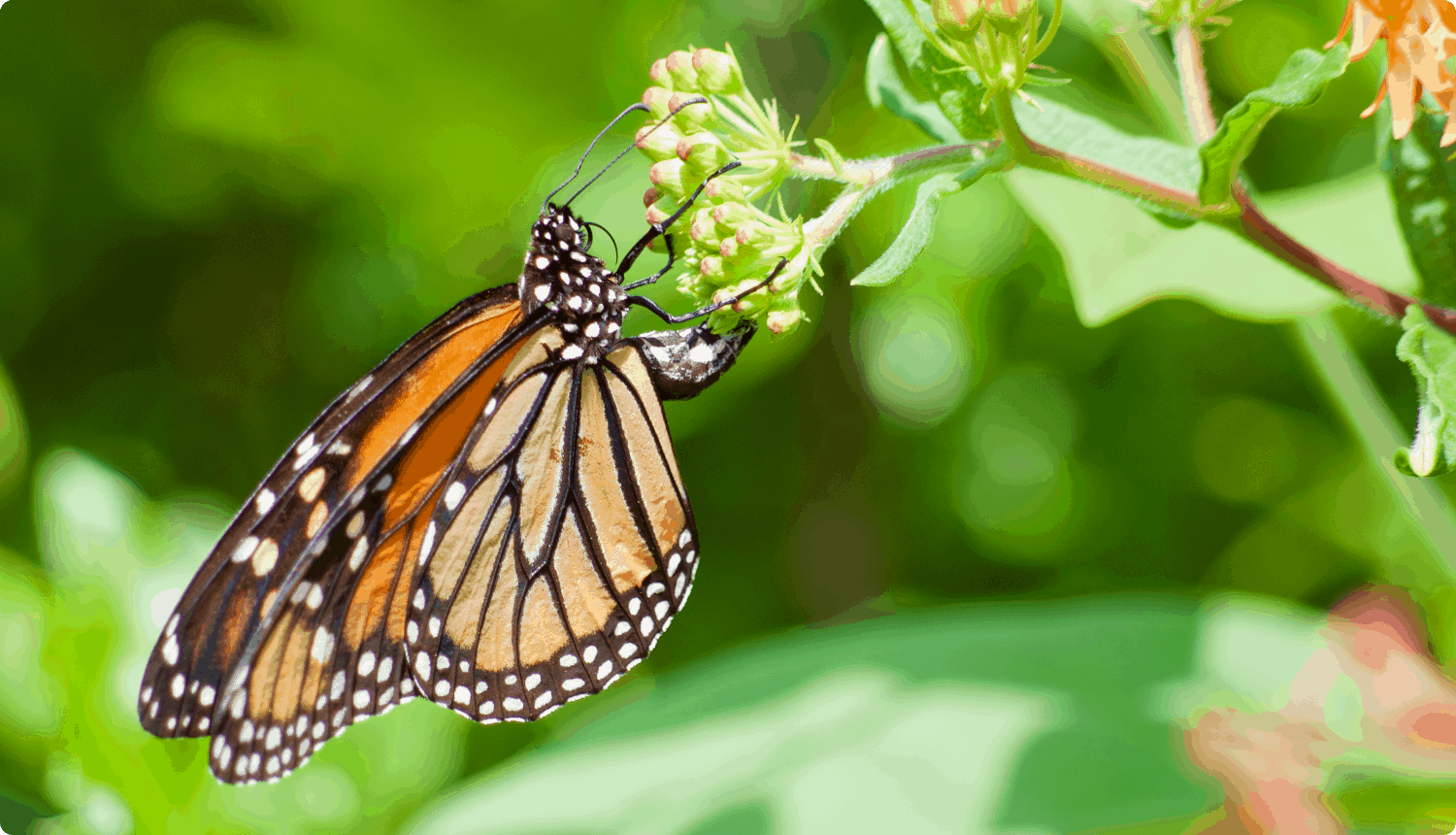
Species
Monarch butterfly (Danaus plexippus)
Principal Biologist(s)
Magnus McCaffery
Project Location
Z Bar Ranch, KS
Bad River Ranches, SD
Avalon, FL
Nonami, GA
Project Partners
US Fish & Wildlife Service
Conservation Problem
The primary threats to monarch butterflies and other native pollinators are habitat loss and pesticides.
Project Goals
We aim to conserve and restore milkweed and other wildflower communities on Turner properties to benefit monarch butterflies and other native pollinators.
Objectives
We aim to manage for and increase suitable habitat for monarch butterflies and other native pollinators on Turner properties through milkweed (Asclepias spp.) and other native wildflower plantings, as well as habitat management. Within five years, we aim to reestablish robust, reproducing populations of swamp milkweed (A. incarnata) at the Z Bar and Avalon to include >500 plants at four sites on each property. At Bad River we will collect seeds from extant showy milkweed (A. speciosa) stands and distribute them in recently disturbed areas. We will also determine if showy milkweed is an effective vegetative barrier to black-tailed prairie dog expansion. As these and other milkweed species become established, we will provide local ecotype seeds to partners and other landowners who want to improve habitat for native pollinators.
Supporting Rationale for Objective
Most Turner properties lie within the spring and fall migration routes of the monarch butterfly and can reasonably be expected to support monarch populations with restoration and conservation of milkweeds and other wildflowers. The Z Bar and Avalon are particularly well suited to monarch butterfly conservation because both properties support prescribed fire which results in diverse wildflower communities. Both are also located where the first generation of monarchs migrating north from Mexico lay eggs, setting the foundation for the species’ multi-generational transnational migration.
At Avalon and the Z Bar, a highly preferred host plant for monarchs — swamp milkweed — is largely absent. At Bad River another preferred host plant — showy milkweed —exists, but in widely scattered and small stands. Why these two preferred host plants are uncommon — particularly swamp milkweed at Avalon and Z Bar — is unknown, although it seems likely that it is a legacy of herbicide use at those properties. With assisted colonization and habitat management we aim to increase the suitability of these properties for monarch butterflies and all native pollinators.
Strategies
We will increase pollinator habitat through milkweed plantings and habitat management. At the Z Bar and Bad River, we will collect local milkweed seeds and broadcast those seeds in unoccupied suitable habitat. At Avalon we will collect swamp milkweed seeds, germinate them in plug pots and plant them in unoccupied suitable habitat.
Project Background
In response to the unprecedented decline of such an iconic insect, TESF teamed up with federal, state and non-profit partners to initiate multiple monarch butterfly habitat conservation and recovery projects on Turner properties. Central to this effort will be restoring preferred monarch host plants on Turner properties, and adapting management practices to benefit these early successional, disturbance-loving plants.
Beginning in 2015, we began annual milkweed surveys at Avalon, the Z Bar, and Bad River to determine species abundance and diversity to guide restoration efforts. Results indicated a robust redring milkweed (A. variegata) community but few other species at Avalon, while Z Bar supports the most diverse milkweed community of the Turner properties where nine species were identified, many of which persist in relatively large stands. Both Avalon and the Z Bar support vibrant and robust wildflower communities, a reflection of the sensible use of prescribed fire on those landscapes. Two milkweed species have been documented at Bad River, with showy milkweed being the most common.
We have investigated two principal methods to increase milkweed diversity and abundance: seed plantings and plug plantings, with the latter showing more promise for restoring an extirpated milkweed species. Plug plantings at Avalon and seed plantings at Bad River originated from local ecotype specimens. The seed and plug plantings at the Z Bar and plug plantings at Bad River were regionally sourced.
Project Activities in 2018
The local ecotype milkweed planting efforts at Bad River and Avalon, which began in 2016, produced seed pods for the first time in 2018. Some of these pods were collected and prepared for plantings in the spring of 2019.
Locally collected showy milkweed seeds were planted at three locations in the Z Bar wetlands and monarch butterfly surveys at the Z Bar resulted in 1.25 monarch sightings per hour. Upland milkweed surveys at the Z Bar indicate one milkweed stem every 75.6 square meters, or approximately 2,267,599 milkweed stems at the ranch. Four milkweed species were identified on the survey plots and an additional four were noted off the plots. At Bad River we identified two species of milkweed and established showy milkweed at 12 new locations.
Our efforts to restore milkweed on Turner properties over the past three years has resulted in an increase in milkweed abundance and diversity; however, for the effort involved, the results have not always been as successful as anticipated. Experimenting with different milkweed species, habitats, and propagation techniques has often resulted poor survival. Data collected in 2018 suggests one cause of poor survival appears is browsing on young and vulnerable milkweed stems by bison. Future plantings at Bad River and the Z Bar will focus on areas inaccessible to bison.
Proposed Future Activities
Through trial and error we have developed what we believe is a reasonable approach to expanding existing milkweed populations and reintroducing extirpated milkweed species to Turner properties. Rather than creating new habitat solely for the purpose of growing milkweed, we will instead focus on increasing existing populations by capitalizing on the habitat created by routine ranching activities which result in soil disturbance and spreading seed collected from that ranch into those areas. For rare or extirpated milkweed species, we will continue to establish new populations using plug plantings.
